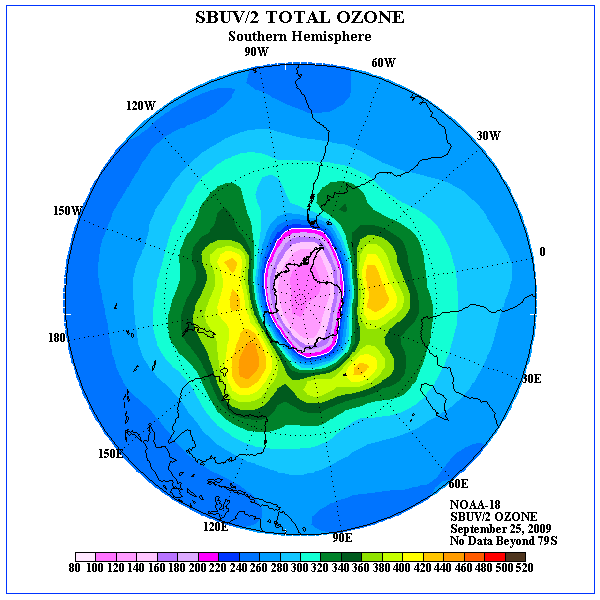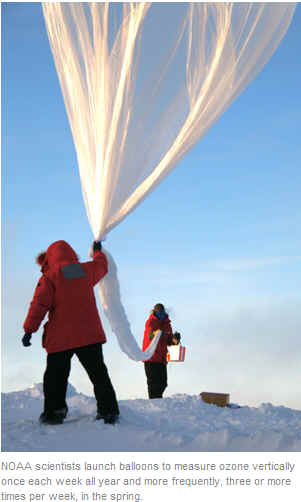
|
||||||||||||||||||||||||
|
Significant Ozone Hole Remains Over Antarctica
November 17, 2009 NOAA-The Antarctic ozone hole, which fluctuates throughout the late winter and spring in the southern hemisphere, reached its 2009 peak circumference in late September, according to measurements by NOAA researchers. Slightly smaller than the North American continent, the ozone hole covered 9.2 million square miles, according to NOAA satellite observations. This ranks as the 10th largest since satellite measurements began in 1979. Ozone over South Pole Station, Antarctica, also reached its thinnest point of the year on Sept. 26. Measured in Dobson Units (DU) that indicate the amount of ozone in a vertical column of air, the 2009 low level – 98 DU – is the seventh smallest since 1986. The record low of 89 DU was recorded on Oct. 6, 1993. The atmospheric ozone layer protects the Earth from harmful ultraviolet radiation. However, it has been damaged by human-produced compounds known as chlorofluorocarbons, or CFCs, which release ozone-destroying bromine and chlorine into the atmosphere. International agreements have strictly limited the use of CFCs since the early 1990s. “The Montreal Protocol has been effective in reducing emissions of long-lived CFC gases, but high enough concentrations remain in the atmosphere to lead to significant ozone destruction in polar regions,” said Bryan Johnson, project leader for the NOAA Earth System Research Laboratory Ozonesonde Group in Boulder, Colo. “Monitoring ozone over Antarctica provides the essential yardstick to see whether we are on the predicted track for recovery based on the current rate of declining CFCs.” Although CFCs are slowly decreasing in the atmosphere, scientists project that the ozone hole will not fully recover before 2060. Extreme cold, ice cloud formation in the stratosphere, and a pattern of rapidly circulating air, called the polar vortex, make the ozone layer over Antarctica much more vulnerable to CFC-destruction than anywhere else. The Antarctic ozone hole reaches its maximum in early spring in the Southern Hemisphere as the South Pole emerges from months of continuous wintertime darkness. At polar dawn, sunlight drives the chemical reactions in which the accumulated chlorine and bromine atoms break down ozone. Scientists expect the ozone hole to gradually disappear as CFC levels fall over the next several decades.
Since 1986, the NOAA Ozonesonde Group has been measuring the extent of the ozone hole vertically over Antarctica with balloons that carry ozone-measuring instruments into the stratosphere. NOAA polar-orbiting satellites probe the area the ozone hole covers as it expands and contracts seasonally. Work on the ground from NOAA’s South Pole Station can be difficult in temperatures approaching -100 degrees F. NOAA engineer Patrick Cullis and NOAA Corps officer Marc Weekley have nearly completed a year-long assignment at South Pole Station where they collect atmospheric data and keep instruments operating. They launch balloons to measure ozone vertically once each week all year and more frequently, three or more times per week, in the spring. “It's actually been hardest to launch during the long dawn before sunrise,” Cullis said. “The landscape starts to brighten, but there are no shadows to warn you of the large clumps of snow left in your path by the movement of bulldozers. Plus, this year, the polar dawn brought an intense 35-knot storm lasting over a week. Even during lulls in the storm, launching large plastic balloons was like running a 50-meter dash in soft snow. My lungs would burn from the combination of 10 pounds of gear, soft snow, and thin air.” Antarctic ozone hole data from these balloon launches and other NOAA measurements is archived online. The measurements and observations are part of NOAA’s suite of climate services. NOAA understands and predicts changes in the Earth’s environment—from the depths of the ocean to the surface of the sun—and conserves and manages our coastal and marine resources. http://www.noaanews.noaa.gov/stories2009/20091117_ozone.html
|




